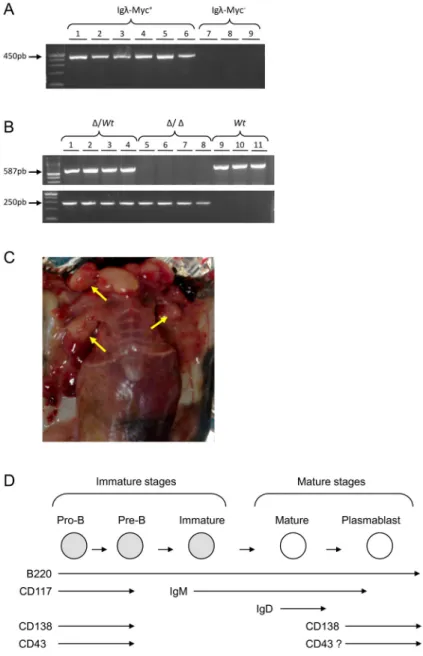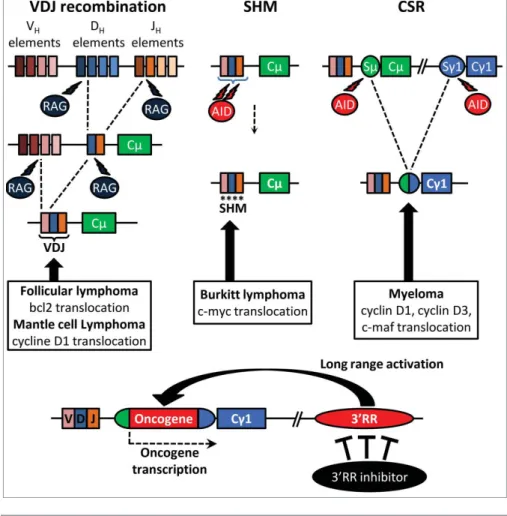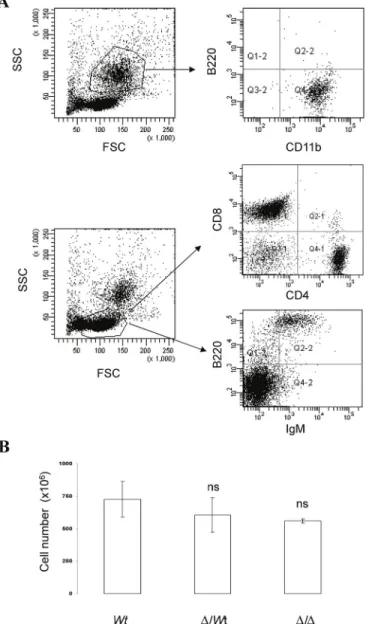Actuellement, on ne sait rien du rôle du 3'RR lors de réactions immunitaires et/ou inflammatoires. Pour cela, nous avons établi un déficit en 3'RR dans un fond génétique murin capable de développer des lymphomes B matures (souris Igλ-Myc).
Introduction �
L'immunité adaptative, au contraire, ajoute à l'immunité naturelle des propriétés de reconnaissance moléculaire et de mémoire qui améliorent considérablement la capacité d'adaptation de l'organisme. Chaque isotype Ig comprend un site de reconnaissance d'antigène spécifique qui est la combinaison de domaines variables de chaînes lourdes (V.
Les translocations chromosomiques nécessitent des cassures double brin de l'ADN au niveau des locus Ig ainsi que des locus oncogènes.
L’activateur intronique Eµ �
La région régulatrice 3’RR de locus d’IgH ��
Rôle de la 3’RR dans la dérégulation oncogénique �
Le séquençage de l’ADN génomique transloqué a également permis de le faire. en particulier dans les sites sujets à des réarrangements d'ADN au cours. les mitochondries dans le cytoplasme cellulaire via l'activation de molécules pro myc affectent positivement la régulation du cycle cellulaire, l'apoptose et le métabolisme et affectent négativement la différenciation et l'adhésion cellulaires. Selon Dang apoptotique, inactivation de gènes suppresseurs de tumeurs comme la protéine du rétinoblastome) ou acquisition d'une capacité proliférative illimitée.
L’importance des cellules T �
B et TNFα sont les principaux facteurs de formation des granulomes mésentériques et séreux.
Résultats �
La région régulatrice située en 3' du locus IgH (3'RR) a été décrite comme un puissant activateur des oncogènes dans les lymphomes B. C'est le passage de ces oncogènes sous la dépendance transcriptionnelle du 3'RR qui semble être l'élément clé de la lymphomagenèse. Le ciblage pharmacologique du 3'RR pourrait donc s'avérer être une piste prometteuse pour tenter de réduire la transcription de l'oncogène transloqué.
Cependant, cela ne pourrait s'avérer être une approche thérapeutique intéressante que si le ciblage pharmacologique du 3'RR s'avère n'avoir aucun effet apparent sur le développement de réactions immunitaires et/ou inflammatoires normales. Dans une première approche, nous avons analysé l'impact de la suppression de 3'RR sur le développement. La cinétique de son apparition est similaire chez les souris normales et déficientes en 3'RR.
Les résultats liés à l'étude de la réponse inflammatoire chez des souris BALB/c déficientes en 3'RR en réponse à Pristine ont également fait l'objet d'un éditorial.
Targeting the oncogene B lymphoma deregulator IgH 3’
Similar to 3'RR-deficient C57BL/6 mice [6], 3'RR-deficient BALB/c mice had similar numbers of bone marrow, spleen, and circulating B cells as BALB/c mice (data not shown). Deletion of the 3'RR did not affect the percentage of splenic marginal zone (MZ), follicular (FO) and transitional (TR) cells (Figure 1B). Wt BALB/c mice, D3'RR/wt BALB/c mice, and homozygous 3'RR-deficient BALB/c mice were investigated.
2B, deletion of the 3'RR had no dramatic effect on the time course of ascites formation. We next investigated whether deletion of the 3'RR altered the cytokine network in exudates of pristane-injected mice. In contrast, Ig levels were similar (p>0.05) for heterozygous D3'RR/wt BALB/c mice and wt BALB/c mice (Table 2).
3'RR-deficient BALB/c mice, heterozygous D3'RR/wt BALB/c mice and wt BALB/c mice were studied.

The IgH 3’ regulatory region inluences lymphomagenesis in Igλ-Myc mice
Percentage of total (mature B-cell lymphomas plus plasmablastic B-cell lymphomas) mature B-cell lymphomas in Igλ-Myc (wt), heterozygous 3'RR-deficient/Igλ-Myc (∆/wt) and homozygous 3'RR-deficient/ . Percentage of total (mature B-cell lymphomas plus plasmablastic B-cell lymphomas) CD43+ mature B-cell lymphomas in Igλ-Myc (wt), heterozygous 3'RR-deficient/Igλ-Myc (∆/wt) and homozygous 3'RR-deiciient/ Igλ-Myc mice. Percentage of total CD5+ B-cell lymphomas in Igλ-Myc (wt), heterozygous 3'RR-deficient/Igλ-Myc (∆/wt), and homozygous 3'RR-deficient/Igλ-Myc mice.
Human myc transcript in immature and mature B-cell lymphomas in Igλ-Myc (wt), heterozygous 3'RR-deficient/Igλ-Myc (∆/wt), and homozygous 3'RR-deficient/Igλ-Myc mice. Analysis of J segments in twelve lymphomas from Igλ-Myc mice and thirteen lymphomas from 3'RR-deficient/Igλ-Myc mice. Analysis of D segments in twelve lymphomas from Igλ-Myc mice and thirteen lymphomas from 3'RR-deficient/Igλ-Myc mice.
Results of the present study indicate that the IgH 3'RR influences lymphomagenesis in Igλ-Myc mice.

ARTICLE
This strong but incomplete defect was also indicated by Southern blot experiments (full blots are included in Supplementary Fig. 2) evaluating hybridSm-Sg1 junctions in 30RR-deficient mice (Fig. 1c). PCR highlighted a small reduction of DSBs in Sm, but a dramatic reduction in Sg1 in 30RR-deficient mice compared with mice (Fig. 3b; full blots are included in Supplementary Fig. 2). The lower accumulation of AID in the Sg1 region of 30RR-deficient mice translates into lower amounts of DSBs and thus reduced efficiency of IgG1 CSR.
Reduced Sm-Sg1CSR in 30RR-deficient mice thus primarily involves reduced accessibility and less frequent DSBs in the Sg1 acceptor. AID-deficient and 30RR-deficient mice carry the CSR defect by completely different mechanisms, namely a lack of DSBs (in both Sm and Sg1) or a biased occurrence of DSBs (normally targeting Sm but not Sg1). In contrast, 0 miRNAs were down-regulated and 11 miRNAs were up-regulated in 30RR-deficient mice (Supplementary Figure 4) compared with wtmice.
Medvedovic, J. et al. Flexible long-range loops in the VH gene region of the Igh locus likely facilitate generation of a diverse antibody repertoire.

The IgH 3 ′ regulatory region governs μ chain transcription in mature B lymphocytes and the B cell fate
The mean membrane density of IgMa (but not IgMb) was reduced in heterozygous aΔ3’RR/bwt compared with awt/bwt mice ( Fig. 2C ). A reduced membrane density of IgMa (but not IgMb) was found in heterozygous aΔ3'RR/bwt mice compared to awt/bwt mice (Figure 2E). In aΔ3’RR/bwt mice, the proportion (but not numbers) of transitional (TR) IgMaAA4.1+ splenic B cells was increased compared with awt/bwt mice ( Fig. 3D , left panel).
The mean IgMa (but not IgMb) intensity was significantly reduced in aΔ3'RR/bwt compared to awt/bwt mice in TR, FO and MZ B cells (Figure 3E). A representative experiment out of ten is shown for aΔ3'RR/bwt and awt/bwt mice. Mean ± SEM of ten aΔ3'RR/bwt mice, ten awt/bwt and four aΔEμMARs/bwt mice.
Heterozygous IgH aΔ3'RR/bwt mice and mixed Sv/129 × C57BL/6 mice (IgH awt/bwt) were used for cell sorting experiments.

Discussion & Perspectives �
During B cell development, V(D)J recombination, SHM, CSR and Ig synthesis are coupled with transcriptional accessibility of IgH loci. Mouse models exploring the role of 30RR in B-cell physiology and in B-cell malignancies should provide useful indications about the pathophysiology of human B-cell proliferations. Therefore, targeted inhibition of 30RR may theoretically provide a therapeutic strategy for the treatment of a wide variety of mature B-cell lymphomas.
A limitation of the pristane mouse model is that inflammation is limited to the peritoneal cavity. Indeed, studies have shown that deletion of the 30RR modulates B cell fate by downregulating BCR signaling, which is critical in B cell malignancies. The transcription level of the c-myc transgene is identical in B-cell lymphomas from wt and 30RR-deficient mice, suggesting that the 30RR does not directly regulate the expression of the oncogene under the control of the Igl enhancers.
Although it does not directly affect the expression of the translocated oncogene, the absence of the 30RR alters B-cell lymphoma phenotypes by impairing the later steps of B-cell ontology.

Elucidation of the enigmatic IgD
After functional V(D)J recombination, bone marrow immature B cells express a BCR consisting of surface IgM. In secondary lymphoid organs, mature B cells simultaneously express surface IgD of the same specialty as surface IgM by alternative splicing of a pre-mRNA composed of V(D)J and both C� and C� heavy chain constant exons (Moore et al., 1981; Preud'homme et al., 2000; Chen and Cerutti, 2010). After encountering antigen, in sufficient lymphoid tissue structures that provide additional signals (direct interactions with T cells and follicular dendritic cells and binding of cytokines secreted by such cells), activated B cells undergo classical class switch recombination (cCSR) and replace the C� gene with C�, C� or C�, thereby generating secondary IgG, IgA and IgE BCR and antibody classes with the same antigenic specificity but new effector functions.
This recombination targets specific stretches of repetitive DNA (S regions) preceding C� and all C�, C�, and C� genes and requires the DNA-editing enzyme activation-induced deaminase (AID; Pavri and Nussenzweig, 2011) ). Genomic disruption or complete deletion of the 3�RR in the mouse abolishes cCSR to all IgG, IgA and IgE classes (Vincent-Fabert et al., 2010a,b; Pinaud et al., 2011). Recently, 3�RR was also reported to be transcribed and itself to undergo AID-mediated mutation and recombination around phylogenetically conserved switch-like DNA repeats, highlighting its close functional partnership with AID (Péron et al., 2012).
Despite the absence of a repetitive S region upstream of C� and similar class switching from IgM to IgG, IgA and IgE, some CD38+ human B cells from tonsils carry an IgH locus switched to IgD expression after an AID-mediated deletion.
Because 3�RR-deficient mice are known to be almost completely defective in cCSR (Vincent-Fabert et al., 2010b), we also checked them for ��CSR. In contrast to mice, human IgD+IgM� had extensive SHM in their IgV genes, indicating their clonal relationship (Arpin et al., 1998). In contrast to mice and humans, an I� exon has recently been reported in the bovine IgH locus (Xu et al., 2012).
There is extensive somatic mutation of the IgH V region in human IgD+ cells (Arpin et al., 1998), but not in mice. CSR; analysis of S�-S� junctions showed, as in mice, a preference for using the microhomology-based end-joining pathway (Xu et al., 2012). The 3�RR is obligatory for CCSR towards IgG, IgA and IgE isotypes (Vincent-Fabert et al., 2010b).
Genomic DNA prepared from IgD+IgM� cells from 3RR-deficient mice was digested with EcoRI and analyzed by Southern blot with a 32P-labeled JH probe (Truinet et al., 2007).

Ig synthesis and class switching do not require the presence of the hs4 enhancer in 3'.







